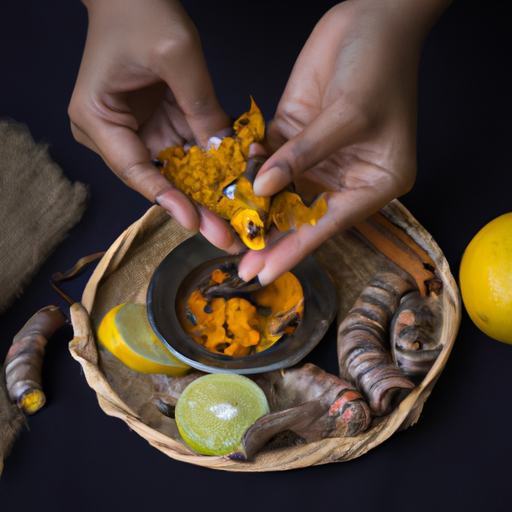As someone who values health, I make it a point to include natural remedies in my everyday life. Turmeric is one of my favorite ingredients because of its many health benefits.
Turmeric, also known as Curcuma longa, is a plant from the ginger family that has been used in traditional medicine for centuries. It contains a potent compound called curcumin, which has anti-inflammatory and antioxidant properties that can help combat various diseases.
One of the most convenient ways to consume turmeric is through turmeric tea. However, not all turmeric teas are created equal when it comes to their concentration of curcumin. In this article, I will delve into how much turmeric is typically found in a bag of turmeric tea and what factors can affect its concentration.
We will also examine different brands of turmeric tea and provide tips on how to increase the amount of turmeric in your brew for maximum nutritional value and health benefits.
Key Takeaways
- Not all turmeric teas are equal in curcumin concentration, as the quality of turmeric used and brewing method can affect potency.
- Adding healthy fat like coconut oil or almond milk can increase curcumin absorption.
- Black pepper can enhance curcumin absorption.
- Turmeric tea typically contains around 1-2 grams of turmeric per serving, and recommended daily curcumin dosage for general health benefits is 500-2,000 mg.
Understanding Turmeric and Its Health Benefits
You’ll want to know the amazing health benefits of turmeric, and how much of it you’ll find in a bag of turmeric tea!
Turmeric is a spice that has been used for centuries in traditional medicine. Its active ingredient, curcumin, has anti-inflammatory and antioxidant properties. Studies have shown that curcumin can help reduce inflammation, improve brain function, lower the risk of heart disease, and even potentially prevent cancer.
Because of its numerous health benefits, turmeric supplements have become increasingly popular. However, incorporating turmeric into your diet through recipes such as curries or adding it to smoothies can also be beneficial.
When it comes to drinking turmeric tea specifically, one bag usually contains about 1-2 grams of ground turmeric root. This amount may vary depending on different brands and blends.
With this information in mind, let’s explore the different types of turmeric tea available!
Different Types of Turmeric Tea
There’s nothing quite like sipping on a warm and comforting blend of spices found in turmeric tea, with each type offering its own unique flavor profile. From the classic golden milk to the zesty ginger-turmeric blend, there are numerous ways to enjoy this healthful beverage. But aside from its delicious taste, turmeric tea is also packed with a host of benefits for our bodies.
Turmeric tea benefits include anti-inflammatory properties, improved brain function, and reduced risk of heart disease. Additionally, turmeric contains curcumin, an antioxidant that helps protect against cellular damage and may even have anti-cancer effects. There are countless ways to incorporate turmeric into your daily routine through various recipes such as adding it to soups or smoothies or simply brewing up a cup of tea. With so many options available, there’s no excuse not to reap the rewards of this powerful spice.
As we explore the concentration levels of turmeric in different types of tea further, it’s important to understand the factors that affect these levels.
Factors that Affect Turmeric Concentration
As I delved deeper into the world of turmeric tea, I discovered that there are several factors that can affect its concentration.
Firstly, the quality of turmeric used plays a significant role in determining the amount of curcumin present in the tea.
Secondly, brewing method is another crucial factor as it can either enhance or diminish the potency of this golden elixir.
Finally, tea bag size also affects turmeric concentration since larger bags tend to have more spices and herbs than smaller ones.
Understanding these factors can help you make an informed decision when choosing your next cup of turmeric tea for maximum health benefits.
Quality of Turmeric Used
The amount of turmeric in a bag of turmeric tea may vary depending on the quality of the turmeric used. Turmeric sourcing and processing play a significant role in determining the concentration of curcumin, which is responsible for most of its health benefits. However, some manufacturers may resort to turmeric adulteration or contamination to cut costs.
To ensure that you’re getting high-quality turmeric tea, look for brands that use organic and non-GMO turmeric. Also, check if their products have undergone third-party testing to verify their potency and purity. Some studies suggest that taking between 500 mg to 2 grams of curcumin daily can provide various health benefits, such as reducing inflammation and improving cognitive function.
When it comes to brewing method, there are several ways to prepare turmeric tea that can affect its absorption rate and bioavailability.
Brewing Method
To maximize the benefits of turmeric, it’s important to brew it properly and consider the ingredients used in the recipe. The water temperature and steeping time can greatly affect the amount of curcumin, which is a key compound found in turmeric that provides its anti-inflammatory properties.
Curcumin is only soluble in fat, so adding a source of healthy fat like coconut oil or almond milk can also increase its absorption. When brewing turmeric tea, it’s recommended to use boiling water (212°F) and let it steep for at least 10 minutes. This allows enough time for the curcumin to dissolve into the liquid.
However, be careful not to over-steep as this can cause bitterness and reduce the nutritional value. There are various turmeric tea recipes available online that incorporate different spices like ginger or cinnamon for added flavor and health benefits.
Now that we’ve covered how to brew turmeric tea properly, let’s take a look at how much turmeric is typically included in a single tea bag.
Tea Bag Size
Hey, did you know that the size of your turmeric tea bag can make a huge difference in how much flavor and health benefits you get?
Most people don’t realize that tea bag material and steeping time are not the only factors that affect their cup of turmeric tea. The size of the tea bag also plays a crucial role in determining how much turmeric is infused into your drink.
The amount of turmeric in a tea bag can vary depending on its size. A smaller bag may contain less than a gram of turmeric, while larger bags can hold up to two grams or more. It’s important to consider this when choosing your preferred brand or type of turmeric tea.
With more turmeric infused into your drink, you’ll reap even greater nutritional benefits such as its anti-inflammatory properties and powerful antioxidants. So be sure to check the size of your tea bags to ensure you get the most out of each cup!
When it comes to selecting the right turmeric tea for you, reading labels is key!
Reading Tea Labels
When you’re checking out the label on your turmeric tea, don’t forget to take note of the amount of turmeric included in each bag. The amount of turmeric can vary greatly between brands and even within different blends from the same brand. It’s important to read the label carefully so that you know exactly what you’re getting.
Some tea labels may also include warnings about potential allergens or common tea additives such as caffeine or artificial sweeteners. Make sure to check for these if you have any allergies or dietary restrictions.
Additionally, it’s important to consider the nutritional value and health benefits of the tea beyond just its turmeric content. Look for teas that are high in antioxidants and other beneficial compounds that can support overall health and wellness.
When comparing turmeric concentrations in different brands, keep in mind that a higher concentration doesn’t necessarily mean a better product. The overall quality of the ingredients, how they are sourced and processed, and other factors all contribute to the effectiveness of the tea.
So take your time to research different brands and find one that meets your specific needs and preferences.
Comparing Turmeric Concentrations in Different Brands
You’ll be surprised to learn how different brands vary in their turmeric concentrations. When comparing prices of turmeric tea, it’s important to consider the sourcing of the turmeric and the concentration levels labeled on each package. Some brands may use low-quality turmeric or add other fillers that dilute the potency of the tea.
To ensure you’re getting the most out of your turmeric tea, here are a few things to look for when comparing concentrations between different brands:
-
Check the percentage of curcuminoids listed on the packaging. Curcuminoids are compounds found in turmeric that’ve been studied for their anti-inflammatory properties.
-
Look for organic and non-GMO labels to ensure high-quality ingredients have been used.
-
Read reviews from other customers who’ve tried different brands and compare their experiences.
Increasing your turmeric concentration can be achieved by adding black pepper to your tea, which has been shown to enhance absorption of curcuminoids into the body. Keep reading to find out more about this simple tip!
How to Increase Turmeric Concentration in Your Tea
If you want to boost the potency of your turmeric tea, try adding a pinch of black pepper to enhance absorption. Black pepper contains piperine which is known to increase the bioavailability of curcumin in turmeric. Curcumin is the active ingredient in turmeric responsible for its anti-inflammatory and antioxidant properties. By enhancing absorption, you can increase the concentration of curcumin in your body, thus maximizing its health benefits.
To further increase the potency of your turmeric tea, consider incorporating other ingredients with high curcumin content. The table below shows common ingredients used in turmeric recipes and their corresponding amount of curcumin per 100 grams.
| Ingredient | Curcumin Content (mg/100g) |
|---|---|
| Turmeric | 3,000-5,000 |
| Ginger | 33-54 |
| Cinnamon | 10 |
| Clove | 13 |
| Cardamom | 10-20 |
By adding these ingredients into your tea or meals, you can create a powerful concoction that not only tastes great but also provides numerous health benefits. However, it’s important to keep in mind that increasing potency also means increasing dosage which may have adverse effects on certain individuals. Let’s dive into turmeric dosage recommendations to ensure safe and effective consumption.
Turmeric Dosage Recommendations
To ensure safe and effective consumption, it’s important to follow recommended dosage guidelines for incorporating turmeric into your daily routine. Turmeric supplements are a convenient way to obtain the beneficial properties of this spice without having to cook with it regularly.
The following bullet list provides dosage recommendations based on scientific evidence:
- For general health benefits, consume 500-2,000 mg of curcumin (the active compound in turmeric) per day.
- To reduce inflammation, aim for a higher dose of 1,000-3,000 mg per day.
- When choosing a supplement, look for one that contains black pepper extract (piperine), which can enhance the absorption and effectiveness of curcumin.
Turmeric has been studied extensively for its potential health benefits, particularly in reducing inflammation throughout the body. By incorporating proper dosages of turmeric into your daily routine through supplements or cooking with the spice itself, you can take advantage of these benefits without putting yourself at risk for any negative side effects.
However, it’s important to be aware of potential side effects associated with excessive consumption – let’s explore those further in the next section.
Potential Side Effects of Turmeric Consumption
Be aware of potential side effects associated with excessive consumption of turmeric, as it can lead to digestive issues and interact negatively with certain medications.
While turmeric is generally considered safe for consumption in moderate amounts, taking too much can cause gastrointestinal problems such as bloating, nausea, and diarrhea.
Additionally, individuals who are on blood thinning medications or have a bleeding disorder should exercise caution when consuming turmeric supplements since it can further increase the risk of bleeding.
Turmeric has been shown to have numerous health benefits due to its anti-inflammatory properties and high antioxidant content. However, it’s important to be mindful of how much you consume and any potential interactions with other medications.
As with any dietary supplement or herb, it’s best to consult with your healthcare provider before adding turmeric into your daily routine. Understanding the safety considerations associated with turmeric will help ensure that you receive all the nutritional value and health benefits without any negative side effects.
Safety Considerations
As we discussed earlier, there are potential side effects to consuming turmeric. However, it’s important to note that these side effects are typically only associated with high doses of the spice or supplement form. When consumed in moderation, turmeric can be a safe and healthy addition to your daily diet.
When it comes to turmeric tea, it’s important to pay attention to dosage. While the amount of turmeric in each bag of tea can vary depending on the brand, most contain around 1-2 grams per serving. This is a relatively low dose and should not cause any adverse effects for most people. However, if you have any concerns about how much turmeric you’re consuming through tea or other sources, it’s always best to consult with a healthcare professional.
In addition to dosage considerations, it’s also important to be aware of potential interactions between turmeric and other medications or supplements you may be taking. Turmeric has been shown to interact with certain blood thinners and stomach acid reducers, so if you’re taking these types of medications it’s especially important to talk with your doctor before adding turmeric tea (or any other form of the spice) into your routine.
To further ensure safety when consuming turmeric tea:
- Stick to recommended dosages
- Talk with a healthcare professional if you have any concerns
- Be aware of potential interactions with medications or supplements
- Purchase from reputable brands/sources
- Store properly (in a cool dry place away from sunlight)
Frequently Asked Questions
How long does it take to see the health benefits of drinking turmeric tea?
I’ve found that the health benefits of drinking turmeric tea can be seen within a few weeks. It’s best to drink it in the morning or evening after Turmeric tea preparation, as studies show it may improve digestion and reduce inflammation due to its high antioxidant content.
Can turmeric tea be used to treat specific medical conditions?
Turmeric tea benefits are vast, but dosage is crucial for treating specific medical conditions. It’s important to note that turmeric tea vs supplements may have varying levels of effectiveness based on individual needs and health goals.
Is it safe to consume turmeric tea while pregnant or breastfeeding?
As a healthcare professional, I advise pregnant or breastfeeding women to avoid turmeric tea due to its potential side effects. While it has some health benefits, the risks outweigh the benefits in this case.
How does the quality of the turmeric used in tea affect its concentration and effectiveness?
Using high-quality turmeric in tea can increase its concentration and effectiveness for health benefits. However, it’s important to consider medical conditions and medication interactions before consuming during pregnancy. A little goes a long way!
Are there any interactions between turmeric and medications that should be avoided?
Drug interactions and precautions should be taken when consuming turmeric, especially for those taking blood thinning medication or with gallbladder issues. Turmeric has shown anti-inflammatory properties and may improve cardiovascular health, but its effects on medication absorption require caution.
Conclusion
In conclusion, turmeric tea is a great way to enjoy the health benefits of turmeric while sipping a warm beverage. However, it’s important to be aware of the concentration of turmeric in your tea and choose brands that offer higher concentrations for maximum benefits. Reading labels and researching different brands can help you make an informed decision when shopping for turmeric tea.
According to a study published in the Journal of Agricultural and Food Chemistry, the average concentration of curcuminoids (the active compound in turmeric) in commercial turmeric powder ranges from 1.39% to 4.14%. This means that if you’re looking for a highly concentrated source of curcuminoids, it may be worth investing in a high-quality brand or supplement. As always, consult with your healthcare provider before adding any new supplements or herbs to your diet.










